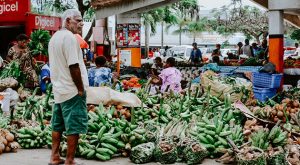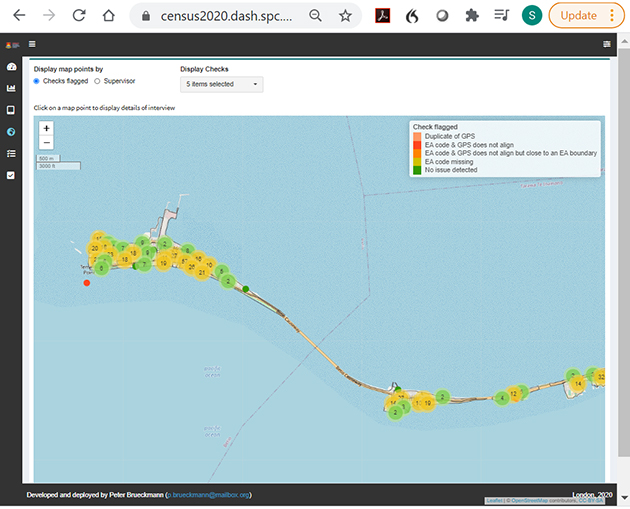Pacific Islands Making the Move to Electronic Data Collection
 13 Juli 2021
13 Juli 2021

Credit: Unsplash, Adli Wahid
By External Source
KIRIBATI, Vanuatu, Jul 12 2021 (IPS-Partners)
Between 2010 and 2020, many Pacific Islands and Territories have updated their traditional data collection processes, embracing new technologies. The island nations Kiribati and Vanuatu, among others, successfully switched to computer-assisted personal interviewing (CAPI), a new data management system and a survey monitoring dashboard. The innovations implemented with support from the Pacific Community helped to weather the impact of the pandemic on census activities and to become fit for the purpose of tracking the Sustainable Development Goals (SDGs).
“With limited internet access in the Pacific Island region, and the additional training required, the decision to switch to an electronic collection process was not an easy move to make initially. However, we and other national statistical offices across the region have reported a handsome payback,” says Aritita Tekaieti, Republic Statistician in Kiribati.
The CAPI format, for example, is cost effective and user friendly. The interviewers use a tablet, mobile phone or a computer to record answers. The technology’s self-correcting function means inconsistencies and mistakes are picked up and resolved during data capture, making the post-enumeration phase much more efficient.
In November 2020, Kiribati and Vanuatu embraced other technologies as well to conduct their national population and housing census. Both countries halted international travel following the onset of the Covid-19 pandemic, which meant technical assistance had to be provided remotely. To overcome some of the challenges, the Pacific Community developed a real-time, online data management system and interactive monitoring dashboard for both the national statistical offices in Kiribati and Vanuatu.
The technologies are critically important for island states like Kiribati, which comprises numerous islands dispersed over millions square kilometres of ocean. The survey monitoring dashboard, for example, addresses challenges in conducting face-to-face surveys in the region’s remote villages and communities.
“Surveys often require monitoring during data collection to ensure progress. Monitoring interviewers in face-to-face surveys is necessary as individual interviewer behaviour often contributes to the quality of surveys. Thus, accurate fieldwork monitoring is becoming more and more important,” explains Epeli Waqavonovono, Director of the Statistics for Development Division of the Pacific Community.

As part of the monitoring dashboard, geographic visualisation of fieldwork can be an additional way to monitor progress and potential problems. In an ideal situation, the map-based tool can enable survey supervisors to provide the census coordinators with valid evidence of difficulties or poor performance in fieldwork. The timely discovery allows for faster interventions such as replacement or retraining of enumerators or the reinforcement of problematic geographic areas with additional interviewers. The benefits of monitoring the performance of censuses and surveys through a well-designed dashboard are evident.
“The dashboard is superbly helpful for our monitoring. The maps with red and orange points really help us in spotting errors. I viewed the dashboard every day and managed to download the check files and send them over to my headquarters to deal with any errors and inconsistencies in the interviews from the field,” says Agnether Lemuelu, Deputy Government Statistician at the Ministry of Finance and Economic Development in Kiribati.
The tools help to improve data timeliness, field monitoring, better supervision, and data quality checks, for example, through external dashboards and data quality systems, as well as the communication between headquarters, supervisors, and enumerators.
“The Pacific Sub-regional Office of the United Nations Population Fund (UNFPA) supports the Pacific Community in its roll-out of CAPI and remote monitoring systems because in addition to promoting efficient and timely data collection, the technology can help to ensure adherence to international census methodology and standards. This facilitates data comparability among the Pacific countries and with the rest of the world,” says UNFPA Pacific Director, Dr Jennifer Butler.
“UNFPA recognizes the value of having tools that can be rapidly modified and tailored to national level needs while encouraging sharing of experiences across countries. Furthermore, the tools can also support the development of innovative approaches to data analysis and dissemination including visualization of results which can help to build the case for those furthest behind, particularly women, young people and the disabled.”
Censuses for the SDGs
Censuses count everyone and they therefore collect information on important populations, such as those with disability. Censuses are the data source for populating 15 percent of the Pacific SDG indicators. In lieu of comprehensive population-based administrative databases in the Pacific region, the census is the fundamental denominator for all population-based indicators of the SDGs. Censuses therefore contribute data towards 45 percent of the Pacific SDG indicators. This initiative was in the spirit of SDG 17 (Partnerships for the Goals) given it was a joint collaboration with the national statistical offices, UNFPA and the Pacific Community.
Data produced via the conduct of a Population and Housing Census are used in a wide array of planning and policy applications, ranging from education and health care to infrastructure and food security. Census data are used in the preparation of population projections, which are fundamental for social and economic planning. The census also serves as the sampling frame for other population-based social and economic surveys, complementing the collection and use of other population-based development microdata for applications such as ending poverty (SDG 1 – No Poverty) and hunger (SDG 2 – No Hunger), ensuring equal and sustained access to good health, education, water, sanitation and hygiene services, energy and work for all (SDGs 3 to 10).
Censuses are designed to provide information for policy and planning purposes across a broad spectrum of sectors and themes, which is intended to be used to guide social, economic and cultural development of the Pacific nations. The initiative aims to leave nobody behind.
Data is not evidence until it is in a useful format and in the hands of the decision makers, whether it be for policy development, prioritization for resources allocation or for designing program interventions. It is only then that the importance of timely and high-quality data becomes apparent. The Pacific Community, with UNFPA support, hopes to accelerate the process of putting the data in the right hands by continuing to build on these initial achievements.
Source: The Pacific Community (SPC)
